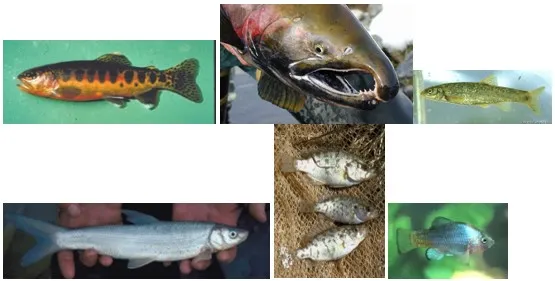Photo: Some endemic fishes of California: Little Kern Golden Trout (top left). SONCC Coho Salmon (top center). Santa Ana Speckled Dace (top right), Desert Pupfish (bottom right), Sacramento Perch (bottom, middle), Sacramento Splittail (bottom left).
See Moyle and Leidy (2023) for much more detailed version of this essay. https://doi.org/10.1017/9781108758826
Few things give the authors of this essay more pleasure than swimming in a California stream on a hot summer day, wearing a mask and snorkel, and observing diverse native fishes behaving naturally. But being able to watch such fishes may be a passing phenomenon, not only here, but globally. Freshwater habitats are disappearing or being rapidly modified, a reflection of the ever-expanding demands of people, accelerated by global climate change. Not surprisingly, there is a global freshwater biodiversity crisis, of which fish are one of the most conspicuous indicators. There is widespread agreement that the crisis is real (e.g., Dudgeon et al. 2006; Strayer and Dudgeon 2010; Darwell et al. 2018, Tickner et al. 2020).
We started to document this crisis over 30 years ago (Moyle and Leidy 1992) when we concluded that, conservatively, 20% of the world’s freshwater fishes were already extinct or in severe decline towards extinction. Six years later, Leidy and Moyle (1997) confirmed this estimate using better information. In our most recent iteration, Moyle and Leidy (2023) concluded that “…without extraordinary measures, at least 40-50% of all freshwater fish species will be extinct in the wild or close to it by the end of the century, if not sooner (p. 201).” In the analysis, we relied on readily available data from the International Union for the Conservation of Nature (IUCN), which attempts to keep track of the status of all species of plants and animals. IUCN (2012) has nine categories for species status: extinct, extinct in the wild, critically endangered, endangered, vulnerable, near-threatened, least concern, data deficient, and not evaluated. Critically endangered, endangered, and vulnerable species are those ‘threatened with extinction’. Definitions of status categories are found in IUCN (2012) and Moyle and Leidy (2023).
The number of unique freshwater fish species on Earth is currently estimated to be over 18,000 (51% of all known fishes) and climbing (IUCN Red List 2022). According to IUCN, almost 3000 species (23% of the 13,276 species assessed) are threatened with extinction. These fishes are distributed among all major taxonomic orders, showing that they occur in freshwater habitats worldwide and are taxonomically diverse. Half of all assessed fishes are widespread or abundant, so they are not threatened with extinction and are classified by the IUCN as of “least concern”. Unfortunately, another 2556 fish taxa (19%) are ’data deficient’, lacking sufficient information for IUCN to assess extinction risk. The comparative lack of information on threatened fishes is reflected in the scientific literature on freshwater fishes, which is primarily about game fishes (Guy et al. 2021).
So how does California compare with the rest of the world in the proportion of its fishes on a pathway to extinction? The comparison of IUCN evaluations with California’s provides a test of both systems because the California freshwater fish fauna is comparatively well-documented, and the state is geographically well-defined. Of the 131 native taxa recognized […]
Full article: californiawaterblog.com

